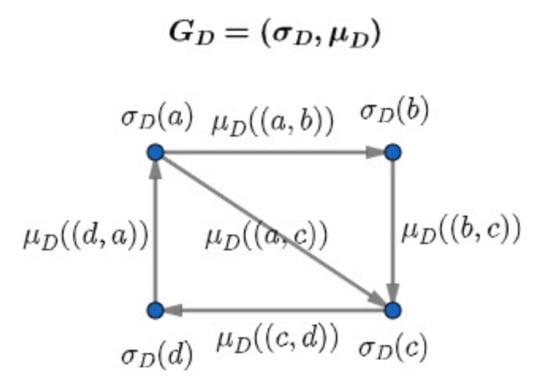Abstract
A new domination parameter in a fuzzy digraph is proposed to espouse a contribution in the domain of domination in a fuzzy graph and a directed graph. Let be a directed simple graph, where is a finite nonempty set and . A fuzzy digraph is a pair of two functions and , such that , where . An edge of a fuzzy digraph is called an effective edge if . Let . The vertex dominates in if is an effective edge. Let , , and . A subset is a dominating set of if, for every , there exists , such that dominates . The minimum dominating set of a fuzzy digraph is called the domination number of a fuzzy digraph and is denoted by . In this paper, the concept of domination in a fuzzy digraph is introduced, the domination number of a fuzzy digraph is characterized, and the domination number of a fuzzy dipath and a fuzzy dicycle is modeled.
1. Introduction
Within the domains of graph theory, a directed graph is an ordered triple consisting of a nonempty set of vertices; a set , disjointed from , of arcs; and an incidence function that associates with each arc of an ordered pair of vertices of [1]. If is an arc and and are vertices such that , then is said to join to ; is the tail of and is its head. For convenience, a directed graph is abbreviated to digraph. For a comprehensive discussion of graph theory, we refer to [2]. On the other hand, the concept of a fuzzy set was introduced in a seminal paper presented in 1965 by Zadeh [3]. Rosenfeld [4] explored the fuzzy relations on fuzzy sets and introduced fuzzy graphs in 1975. Some fundamental operations of fuzzy graphs were introduced by Mordeson and Chang-Shyh [5], and the latest collection of some important developments on the theory and applications of fuzzy graphs was compiled by Mordeson and Nair [6]. Since then, various extensions of fuzzy graphs were offered in the literature, including M-strong fuzzy graphs [7], intuitionistic fuzzy graphs [8], regular fuzzy graphs [9], bipolar fuzzy graphs [10], interval-valued fuzzy graphs [11], and Dombi fuzzy graphs [12], among others. Note that this list is not intended to be comprehensive. We review some basic notions of fuzzy graphs by letting be a set. A fuzzy subset of is a mapping which assigns to each element a degree of membership, . Similarly, a fuzzy relation on is a fuzzy subset of , that is, a mapping , which assigns to each ordered pair of elements a degree of membership, . In a special case where and can only take on the values and , they become the characteristic functions of an ordinary subset of and an ordinary relation on , respectively.
With interesting results and an array of applications, domination in a graph has been a vast area of research in graph theory. It was introduced by Claude Berge in 1958 and Oystein Ore in 1962 [13], with the earliest results and applications put forward by Cockayne and Hedetniemi [14]. The most comprehensive reference on the topic can be found in Haynes et al. [15], with more advanced and latest concepts in Haynes [16] and Haynes et al. [17]. Extended forms of domination in graphs have been vast in the domain literature. Some very recent forms include broadcast domination [18], pitchfork domination [19], Roman domination [20], double Roman domination [21], triple Roman domination [22], captive domination [23], outer-convex domination [24], and paired domination [25], among others. The trajectory of these topics has been exponential in the last decade. Consider as a graph. A subset of a vertex set is a dominating set of a graph if, for every vertex , there exists a vertex such that is an edge of . The domination number of is the smallest cardinality of a dominating set of . As an extension, the concept of domination in fuzzy graphs was introduced by Somasundaram [26]. Let be a finite nonempty set, and be a collection of all two-element subsets of . A fuzzy graph is a set with two functions and such that for all . If is a fuzzy graph on with , then dominates in if . A subset of is called a dominating set in if, for every , there exists such that dominates . The minimum fuzzy cardinality of a dominating set in is called the domination number of and is denoted by .
The notion of fuzzy digraphs can be traced back to the work of Mordeson and Nair [27], with recent advances reported by Kumar and Lavanya [28]. A fuzzy digraph is a pair of function and , where for , is a fuzzy set of , is a fuzzy relation on , and is a set of fuzzy directed edges called fuzzy arcs. An indegree of a vertex in a fuzzy digraph is the sum of the values of the edges that are incident towards the vertex . The outdegree of any vertex in the fuzzy digraph is the sum of membership function values of all those arcs that are incident out of the vertex . The indegree is denoted by and the outdegree by , where is any vertex in . A subset is a fuzzy out dominating set of if, for every vertex , there exists in such that . A fuzzy digraph is complete if, for every pair of directed adjacent vertices, .
The domination in fuzzy digraphs is a new concept in the domain literature, with limited insights. With such a new concept, we propose a new domination parameter in a fuzzy digraph. Motivated by the concepts of fuzzy digraphs [27,28] and the notions of domination of graphs [13], this work intends to advance the literature of domination in a fuzzy graph and a directed graph. All graphs considered in this paper are finite and directed without a loop. We use as a latent directed graph of a fuzzy digraph , where is a vertex set and is an arc set of a directed graph , while is a vertex set and is an arc set of a fuzzy digraph . A set of vertices is a dominating set of if each vertex is dominated by at least a vertex in . The domination number of is the smallest cardinality of a dominating set of . In this paper, the concept of domination in a fuzzy digraph is introduced/defined, the domination number of a fuzzy digraph is characterized, and the domination number of a fuzzy dipath and a fuzzy dicycle is modeled. The contribution of this work lies in providing general results (i.e., theorems, corollaries) of the minimum dominating set of a fuzzy directed graph in order to facilitate new advances on these concepts.
2. Preliminaries
This section provides a new definition of a fuzzy directed graph, introduces some working terminologies, and gives some useful observations in the form of remarks and examples.
Definition 1.
Let
be a directed simple graph, where is a finite nonempty set and . A fuzzy digraph is a pair of two functions and such that for all .
Remark 1.
Theis called a latent (hidden) directed graph of. The term digraph is used to represent a directed graph.
Remark 2.
Letbe a latent digraph of.
- 1.
- is a set of vertices or nodes of a latent digraph, that is,
- 2.
- is a set of directed edges or arcs of a latent digraph, that is,
- 3.
- is a set of vertices or nodes of a fuzzy digraph, that is,
- 4.
- is a set of edges or arcs of a fuzzy digraph, that is,
- 5.
- means the edge or arc is directed fromto.
- 6.
- if.
Example 1.
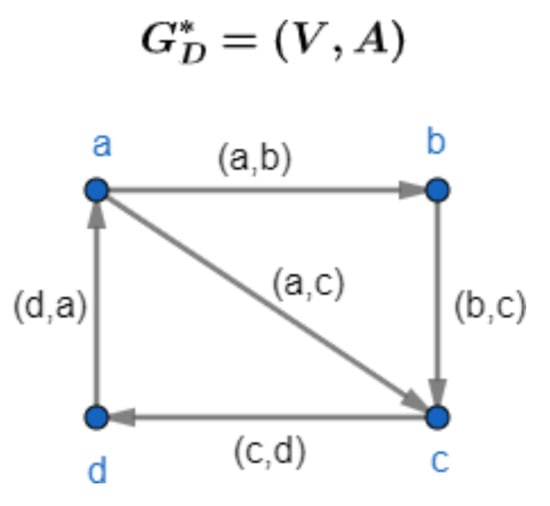

Figure 1.
The is a directed graph.
Example 3.


Figure 3.
is not a fuzzy digraph.
Example 4.
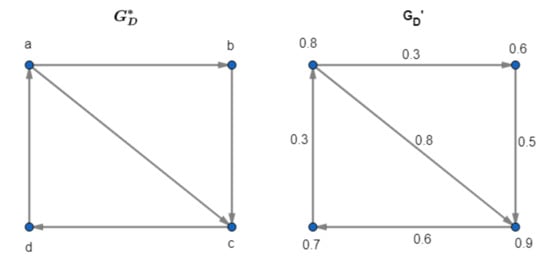
Let
be a latent digraph of as shown in Figure 4. Because for all , it follows that is a fuzzy digraph.

Figure 4.
is a fuzzy digraph.
Definition 2.
Let
be a latent digraph of . The order and size of a fuzzy digraph are defined to b
Example 5.
Definition 3.
An arc
of a fuzzy digraph is called an effective arc if
Example 6.
In Figure 4,is the only effective arc of.
3. Domination in Fuzzy Digraphs
In this section, we define a dominating set in a fuzzy digraph . Further, we characterize the minimal dominating set of a fuzzy digraph and give some useful results.
Definition 4.
Let
. The vertex dominates in if is an effective arc.
Example 7.
Definition 5.
Let
, , and . A subset is a dominating set of if, for every , there exists such that dominates .
Remark 3.
Let
be a fuzzy digraph of and .
- 1.
- Then
- 2.
- Ifis a dominating set of, thenis a dominating set of. The converse is not necessarily true.
- 3.
- The fuzzy cardinality of a minimum dominating set is called the domination number ofand is denoted by, that is,whereis a dominating set of
Remark 4.
Let
be a latent directed graph of a fuzzy digraph . If for all , then the only dominating set of is .
Example 8.
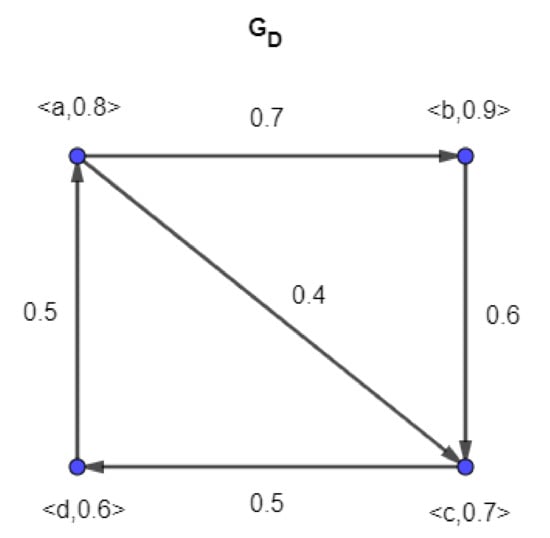
Let
be a latent directed graph of a fuzzy digraph as shown in Figure 5. Because for all , the only dominating set of is . Hence, .

Figure 5.
The dominating set of is .
Example 9.
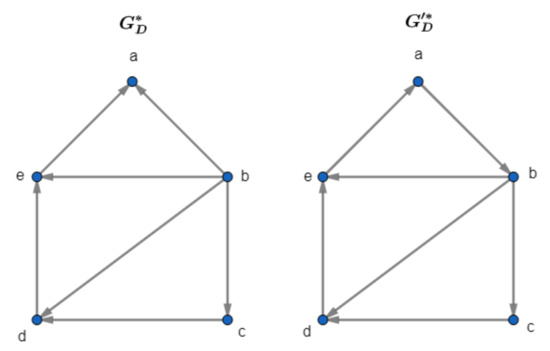
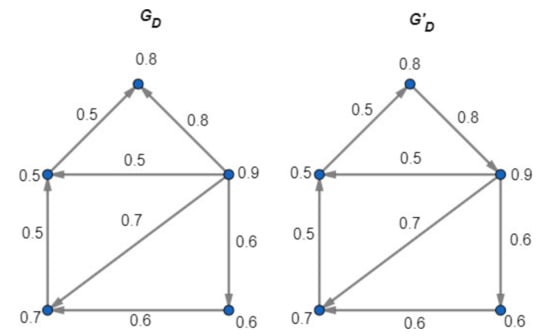
Let
and be latent digraphs of fuzzy digraphs and , respectively (see Figure 6). If
and
then for all . Hence, the set is the minimal dominating set of and the sets , , and are minimal dominating sets of . Further, the domination number of is and the domination number of is (see Figure 7).

Figure 6.
and are the latent digraphs of and , respectively.

Figure 7.
The minimum dominating set of is , that is, and the minimum dominating set of is , that is, .
From the definitions and observations, the following remark is immediate.
Remark 5.
Let
be a latent directed graph of a fuzzy digraph . If , then
Proof.
Because for all , it follows that
□
The following result gives a characterization of the minimal dominating set of a fuzzy directed graph.
Theorem 1.
Let
be a latent directed graph of a fuzzy digraph and . A dominating set of is minimal if and only if, for each , either or for some .
Proof.
Let . If is a minimal dominating set of , then is not a dominating set of . Thus, there exists such that is not dominated by any element of .
Case 1. Suppose . Then, is not dominated by any element of , that is, .
Case 2. Suppose . Then, . Because is a minimum dominating set of , it follows that is dominated by . Thus, for some .
For the converse, the proof is immediate. □
4. Some Special Fuzzy Digraphs
In this section, we introduce the definition of some special fuzzy digraphs . Further, we give the general formula of computing the domination number of .
Definition 6.
A fuzzy dipath (directed path)
is a sequence of effective arcs having the property that the ending vertex of each arc is the same as the starting vertex of the next arc in the sequence.
Remark 6.
Letbe a fuzzy dipath of a latent directed pathwhereis an integer. Then,
- 1.
- ;
- 2.
- ;
- 3.
- .
- 4.
- The verticesandare the first and last vertex, respectively, of a nontrivial fuzzy dipath.
The following result illustrates the domination number of a fuzzy dipath.
Theorem 2.
Let
be a fuzzy dipath. Then, one of the following is satisfied.
- 1.
- 2.
- , where
Proof.
By Remark 6, and
Because is an effective arc for all , it follows that dominate for all .
Case 1. If is an even integer, then for some positive integer . Now, the set is clearly the minimum dominating set of . Note that
Thus, This proves the statement .
Case 2. If is an odd integer, then for some positive integer . Now, the sets
are minimal dominating sets of . Note that
Generally,
Let for . Then
Thus, the minimum of
is the domination number of a fuzzy dipath . Hence, . □
Example 10.

Let be a fuzzy dipath of a latent directed path . (see Figure 8).

Figure 8.
The minimum dominating set of is and the domination number is .
Example 11.


Figure 9.
The minimal dominating set of is and the domination number is .
Corollary 1.
Let
be a fuzzy dipath of a latent nontrivial directed path . If , , then .
Proof.
If is even, by Theorem 2, . Because , , it follows that . Thus,
Similarly, if is odd, by Theorem 2,
Hence, is either if n is even, or if n is odd. Therefore, □
Definition 7.
A fuzzy dicycle (directed cycle)
is a dipath where it starts and ends with the same vertex.
Remark 7.
Let
be a fuzzy dicycle of a latent directed cycle , where . Then,
- 1.
- ;
- 2.
- ;
- 3.
- .
The following result provides the domination number of a fuzzy dicycle.
Theorem 3.
Letbe a fuzzy dicycle of a latent directed cycle where . Then, one of the following is satisfied:
- 1.
- ;
- 2.
- , where
Proof.
Let . Because is a dipath that starts and ends with the same node, the arcs for all and are effective. This means that dominate for all and dominate .
Case 1. If is an even integer, then for some positive integer . Now, the sets and are minimal dominating sets of . Note that
and
Thus, This proves the statement .
Case 2. If is an odd integer, then for some positive integer . Now, the sets
are some minimal dominating sets of . Note that
Generally,
Let . Then,
Further, the sets
are other minimal dominating sets of . Generally,
Let . Then,
Let such that
and
Hence, the domination number of is . This proves statement □
Example 12.
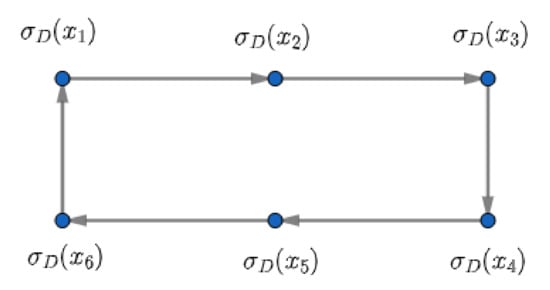

Figure 10.
The minimal dominating set of is and the domination number is .
Example 13.
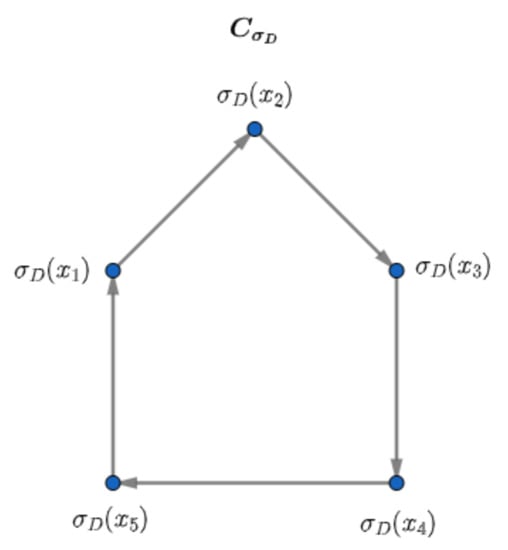

Figure 11.
The minimal dominating set of is and the domination number is .
Corollary 2.
Letbe a fuzzy dicycle of a latent directed cyclewhere. If,, then.
Proof.
If is even, by Theorem 3,
Because , , it is immediate that
(using similar reasoning of Corollary 1.
Similarly, if is odd, by Theorem 3,
Because
and
Hence, is either if is even, or if n is odd.
Thus, □
5. Conclusions
In this work, we introduced the concept of domination in a fuzzy digraph, provided the characteristics of the minimum dominating set of fuzzy digraphs, and modeled the domination number of a fuzzy dipath and a fuzzy dicycle. The domination number in a fuzzy dipath and a fuzzy dicycle was presented and proved. The immediate consequences of the mentioned concepts were all proved. Some related problems are still open for future work.
- (a)
- Characterize the dominating sets of each of the following special fuzzy digraphs—the wheel , the complete bipartite , the star , and the fan .
- (b)
- Find the domination number of each of the following special fuzzy digraphs: , , , and .
Aside from these problems, future works could explore the application of domination in fuzzy digraphs in problem structuring methods commonly used in the literature, such as fuzzy decision-making trial and evaluation laboratory (DEMATEL) [29], fuzzy cognitive mapping (FCM) [30], and fuzzy interpretive structural modelling (ISM) [31], among others.
Author Contributions
Conceptualization, E.E., G.E., C.L. and R.J.B.; methodology, E.E.; validation, E.E., G.E., C.L. and R.J.B.; formal analysis, E.E., G.E., C.L. and R.J.B.; investigation, E.E.; resources, L.O.; writing—original draft preparation, E.E., G.E., C.L. and R.J.B.; writing—review and editing, E.E., G.E., C.L., R.J.B. and L.O.; visualization, E.E. and G.E.; supervision, L.O.; project administration, L.O.; funding acquisition, L.O. All authors have read and agreed to the published version of the manuscript.
Funding
This research is funded by the 2019 CHED Institutional Development and Innovation Grant entitled “Creation of Interdisciplinary Graduate Program Courses for Applied Mathematics and Operations Research as Tools for Innovation”.
Institutional Review Board Statement
Not applicable.
Informed Consent Statement
Not applicable.
Data Availability Statement
Not applicable.
Acknowledgments
We acknowledge the research staff of the CTU-Center for Applied Mathematics and Operations Research.
Conflicts of Interest
The authors declare no conflict of interest.
References
- Bondy, J.A.; Murty, U.S.R. Graph Theory with Applications; Macmillan: London, UK, 1976; Volume 290. [Google Scholar]
- Chartrand, G.; Zhang, P. A First Course in Graph Theory; Courier Corporation: North Chelmsford, MA, USA, 2013. [Google Scholar]
- Zadeh, L.A. Fuzzy sets. Inf. Control 1965, 8, 338–353. [Google Scholar] [CrossRef] [Green Version]
- Rosenfeld, A. Fuzzy Graphs. In Fuzzy Sets and Their Applications; Zadeh, L.A., Fu, K.S., Shimura, M., Eds.; Academic Press: New York, NY, USA, 1975; pp. 77–95. [Google Scholar]
- Mordeson, J.N.; Chang-Shyh, P. Operations on fuzzy graphs. Inf. Sci. 1994, 79, 159–170. [Google Scholar] [CrossRef]
- Mordeson, J.N.; Nair, P.S. Fuzzy Graphs and Fuzzy Hypergraphs; Physica-Verlag: Heidelberg, Germany, 2012; Volume 46. [Google Scholar]
- Bhutani, K.R.; Battou, A. On M-strong fuzzy graphs. Inf. Sci. 2003, 155, 103–109. [Google Scholar] [CrossRef]
- Parvathi, R.; Karunambigai, M.G. Intuitionistic Fuzzy Graphs. In Computational Intelligence, Theory and Applications; Springer International Publishing: Cham, Switzerland, 2006; pp. 139–150. [Google Scholar]
- Gani, A.N.; Radha, K. On regular fuzzy graphs. J. Phys. Sci. 2012, 12, 33–40. [Google Scholar]
- Akram, M. Bipolar fuzzy graphs. Inf. Sci. 2011, 181, 5548–5564. [Google Scholar] [CrossRef]
- Akram, M.; Dudek, W. Interval-valued fuzzy graphs. Comput. Math. Appl. 2011, 61, 289–299. [Google Scholar] [CrossRef] [Green Version]
- Ashraf, S.; Naz, S.; Kerre, E.E. Dombi Fuzzy Graphs. Fuzzy Inf. Eng. 2018, 10, 58–79. [Google Scholar] [CrossRef] [Green Version]
- Ore, O. Theory of graphs, American mathematical society colloquium publications. Am. Math. Soc. Provid. 1962, 38, 270. [Google Scholar]
- Cockayne, E.J.; Hedetniemi, S.T. Towards a theory of domination in graphs. Networks 1977, 7, 247–261. [Google Scholar] [CrossRef]
- Haynes, T.W.; Hedetniemi, S.; Slater, P. Fundamentals of Domination in Graphs; CRC Press: Boca Raton, FL, USA, 2013. [Google Scholar]
- Haynes, T. Domination in Graphs: Volume 2: Advanced Topics; Routledge: London, UK, 2017. [Google Scholar]
- Haynes, T.W.; Hedetniemi, S.T.; Henning, M.A. Topics in Domination in Graphs; Springer International Publishing: Cham, Switzerland, 2020. [Google Scholar]
- Henning, M.A.; MacGillivray, G.; Yang, F. Broadcast domination in graphs. In Structures of Domination in Graphs; Haynes, T.W., Hedetniemi, S.T., Henning, M.A., Eds.; Springer International Publishing: Cham, Switzerland, 2021; pp. 15–46. [Google Scholar]
- Al-Harere, M.N.; Abdlhusein, M.A. Pitchfork domination in graphs. Discret. Math. Algorithms Appl. 2020, 12, 2050025. [Google Scholar] [CrossRef]
- Chellali, M.; Rad, N.J.; Sheikholeslami, S.M.; Volkmann, L. Roman Domination in Graphs. In Topics in Domination in Graphs; Springer International Publishing: Cham, Switzerland, 2020; pp. 365–409. [Google Scholar]
- Yue, J.; Wei, M.; Li, M.; Liu, G. On the double Roman domination of graphs. Appl. Math. Comput. 2018, 338, 669–675. [Google Scholar] [CrossRef]
- Ahangar, H.A.; Álvarez, M.; Chellali, M.; Sheikholeslami, S.; Valenzuela-Tripodoro, J. Triple Roman domination in graphs. Appl. Math. Comput. 2021, 391, 125444. [Google Scholar]
- Al-Harere, M.N.; Omran, A.A.; Breesam, A.T. Captive domination in graphs. Discret. Math. Algorithms Appl. 2020, 12, 2050076. [Google Scholar] [CrossRef]
- Dayap, J.A.; Enriquez, E.L. Outer-convex domination in graphs. Discret. Math. Algorithms Appl. 2019, 12, 2050008. [Google Scholar] [CrossRef]
- Desormeaux, W.J.; Haynes, T.W.; Henning, M.A. Paired Domination in Graphs. In Topics in Domination in Graphs; Springer International Publishing: Cham, Switzerland, 2020; pp. 31–77. [Google Scholar]
- Somasundaram, A.; Somasundaram, S. Domination in fuzzy graphs–I. Pattern Recognit. Lett. 1998, 19, 787–791. [Google Scholar] [CrossRef]
- Mordeson, J.; Nair, P. Successor and source of (fuzzy) finite state machines and (fuzzy) directed graphs. Inf. Sci. 1996, 95, 113–124. [Google Scholar] [CrossRef]
- Kumar, P.K.K.; Lavanya, S. On fuzzy digraphs. Int. J. Pure Appl. Math. 2017, 115, 599–606. [Google Scholar] [CrossRef] [Green Version]
- Lin, C.-J.; Wu, W.-W. A causal analytical method for group decision-making under fuzzy environment. Expert Syst. Appl. 2008, 34, 205–213. [Google Scholar] [CrossRef]
- Kosko, B. Fuzzy cognitive maps. Int. J. Man-Mach. Stud. 1986, 24, 65–75. [Google Scholar] [CrossRef]
- Ragade, R.K. Fuzzy interpretive structural modeling. J. Cybern. 1976, 6, 189–211. [Google Scholar] [CrossRef]
Publisher’s Note: MDPI stays neutral with regard to jurisdictional claims in published maps and institutional affiliations. |
© 2021 by the authors. Licensee MDPI, Basel, Switzerland. This article is an open access article distributed under the terms and conditions of the Creative Commons Attribution (CC BY) license (https://creativecommons.org/licenses/by/4.0/).
